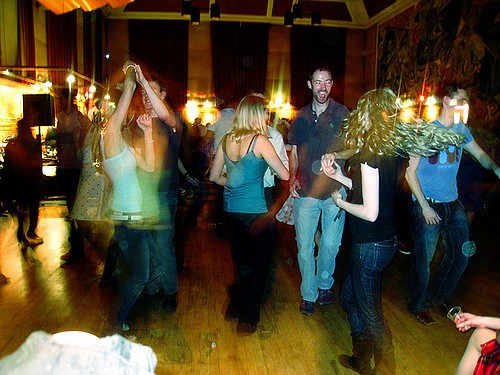Ceilidh Dances
In the Celtic communities, what we now often call Ceilidh dances were originally simply local gatherings which developed into a form of literary entertainment with story telling, recitations and songs; instrumental music and dancing were added later. In those days before radio and television, the performers would almost all be talented locals; any reluctance on their part would be mitigated by appropriate refreshment and the party atmosphere.Events like these can still be found, notably in the more isolated Scottish communities, but dancing to a live band usually predominates. As a visiting participant, it is important to remember that there are many local variants of what we may think of as familiar dances and so it is wise to be a little circumspect. Do not rely on the Dance instructions listed below to be applicable everywhere. "When in Rome . . . ".
Nowadays, one is most likely to encounter a Ceilidh as part of the reception at a Scottish or, more commonly, an ex-patriate Scottish wedding. Even though there will usually be a caller, it is sensible for the organizer to choose those Ceilidh dances which are sufficiently traditional that the names, at least, will be familiar to those expected to participate.
Albeit inevitably subjective and extended to include a few modern Ceilidh dances which have become popular, most of the following dances would be recognized by those who have attended a few Ceilidhs. The first list covers those popular Ceilidh dances for which a MiniCrib or MaxiCrib or a crib diagram exists:
Alphabetical List Of Ceilidh Dances:
And For The Young OnesArbroath 700
Borrowdale Exchange
Britannia Two-step
Bulling Boots
Canadian Barn Dance
Can-Do Ceilidh
Ceilidh Madness
Centenary Circle
Circassian (Big) Circle
Circassian Circle
Circle Waltz
Cramond Island
Cumberland Jig
Cumberland Jig (3-Couple Version)
Cumberland Square
Dashing White Sergeant
Domino Five
Down Unda
Duke Of Perth
Eightsome Reel
Eva Three Step
Fairy Ring
Festival Interceltique
Flying Scotsman (Thurston/RSCDS)
Flying Scotsman (Thurston/RSCDS, 3-Couple Version)
Galloping Carousel
Gay Gordons
Gay Gordons Two Step
Gypsy Girl's Headscarf
Gypsy Girl's Headscarf (3-Couple Version)
Gypsy Shawl
Gypsy Shawl (3-Couple Version)
Gypsy Thread
Haymakers
Hebridean Weaving Lilt
Highland Welcome (Forbes)
Jamie's Jig (St Amand) (the simpler version)
Kelly's Kaper
Kelvingrove Two Step
Knot On A Ferry
La Bastringue
Lads And Lassies Of Livermore
Le Palindrome (Sheffield)
Lomond Waltz
London Celebration
Marie Curie's Reel
Mayflower
Melbourne Cup
Melbourne Cup (3-Couple Version)
Nice To See You
Oidhche Chaluinn for Hogmanay but perhaps danced as a reel or jig.
Pinewoods Two-Step
Postie's Jig
Pudsey Bear
Riverside
Sausage Machine
Scottish Man Of War
Schottische
Scotch Mixer
Sir Andy Murray Of Dunblane
St Bernard's Waltz (Smith)
Stern Polka
Strip The Willow
Swedish Masquarade
T.A.G.
Terrace Loggers' Jig
Veleta
Virginia Reel
Virginia Reel (3-Couple Version)
Waltz Country Dance
Warm Up
Warm Up 2
Warm Up Jig
Wedding Walk
Welcome To Bluebell
Welcome To The Dance
The links are to video instructions but no dance crib or crib diagram is available for:
Boston Two-Step
Pride Of Erin Waltz
all of which often appear on Ceilidh dance programmes. Instructions for these two and for some others which are equally obviously part of the Old Tyme and Sequence Dancing répertoire may be found in Let's have a Ceilidh by Jim Johnstone and Robbie Shepherd; this pocket-sized guide provides instructions for 20 popular dances from the Scottish Country Dancing and the Old Tyme and Sequence Dancing répertoires which are often encountered at a ceilidh. It includes a good, basic introduction to Scottish Ceilidh dancing and the music for each dance, specially chosen by Jim Johnstone to highlight the steps, is ideal for musicians learning to play for these events.
High Country Mixer also links to a video of a dance for which no crib or crib diagram is available; a variant was taught in the RSCDS Online Class of 28 May 2021, during the Covid-19 lockdown in UK.
Dance Information
A cèilidh (Scottish) or céilí (Irish) is a traditional Scottish or Irish social gathering. In contemporary usage, it usually involves playing Gaelic folk music and dancing, either at a house party or a larger concert at a social hall or other community gathering place.Cèilidhs facilitated courting and prospects of marriage for young people and, although discos and nightclubs have displaced Cèilidhs to a considerable extent, they are still an important and popular social outlet in rural parts of Ireland and Scotland, especially in the Gaelic-speaking regions.
In Scotland privately organised cèilidhs are now extremely common in both rural and urban Scotland, where bands are hired, usually for evening entertainment for a wedding, birthday party, celebratory or fundraising event. These may be more or less formal, and very often omit all other traditional Gaelic activity beyond the actual music and dancing. Novices are usually among the participants, so a "dance caller" may teach the steps before music begins for each dance. The more versatile bands will demonstrate the dances too.

Ceilidh At North Kessock, Inverness, Scotland, 2016
Dance information licensed under this Creative Commons Licence 3.0.
Text from this original Ceilidh Dance article on Wikisource.
Image copyright Dani Lurie, https://ceilidhclub.com/, Creative Commons Licence 2.0, via Flickr.
Additional search terms: cayli, ceili.
Back to the top of this Scottish Country Dancing 'Ceilidh Dances' page
